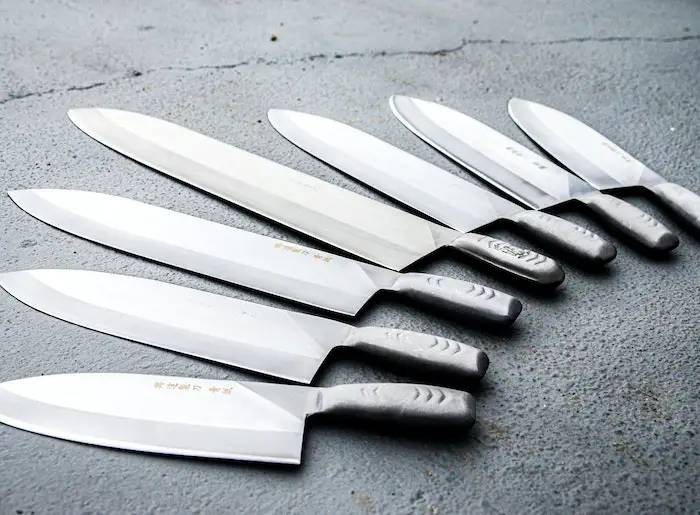Table of Contents
A knife tang is the invisible part of the knife blade that goes inside the handle. There are different types of knife tangs, including hidden tang, extended tang, rat-tail tang, and tapered tang. Each tang type has different effects on the knife and its use. The tang variations are categorized under two major categories, full and partial tangs.
Although unknown to many, this part is very important because it is the backbone of the knife. To help you understand more about knife tangs, let us look at the different types of knife tangs in detail.
What Is A Knife Tang?
A knife tang is the part of the blade that extends into the knife handle. It is that part that holds the blade and the handle together; otherwise, the blade and the handle would separate every time you apply pressure when using a knife.
The blade extends inside the handle, and that is the part known as the tang. It might be invisible, but it is the support system of a knife. It ensures that the blade remains stable and performs its duties without breaking.
Types of Knife Tang
There are many types of knife tangs and they are divided into two major categories; full and partial tangs.
Full tangs
- Hidden tang
- Skeletonized tang
- Encapsulated tang
- Extended tang
Partial tangs
- Rat-tail tang
- Push tang
- Tapered tang
In the next sections, we will discuss different variations of knife tangs: how they are made, their uses, pros, and cons.
Full Tang
A full tang, as the name suggests, is designed to match the size and shape of the knife handle. It is the same length and width as the handle, forming strong and enduring knives.
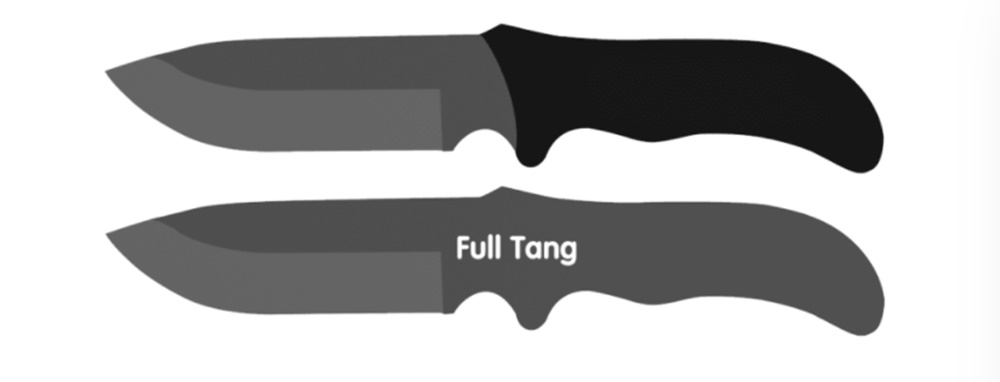
How It’s Made
A full tang is sandwiched between two handle slabs and held together using rivets or epoxy. For some knives, you can see the tang through the handles while it is fully enclosed for some knife designs.
Uses
Full tangs are used for intense and heavy-duty tasks because they are very strong and stable. Full tang knives are suitable for outdoor activities like hunting, cutting beef shanks, and any other cutting activity that requires a robust knife.
Pros
- It is the strongest tang construction
- Can handle heavy tasks
- It offers more stability and control because there is more metal in the handle
Cons
- Full tang knives are heavy because of the large amount of steel inside the handle
- More expensive
- Exposed tangs can get very cold and uncomfortable
Hidden Tang
A hidden tang is covered by the grip material in a way that it cannot be seen or how it is held together. The tang is thinner than the blade.
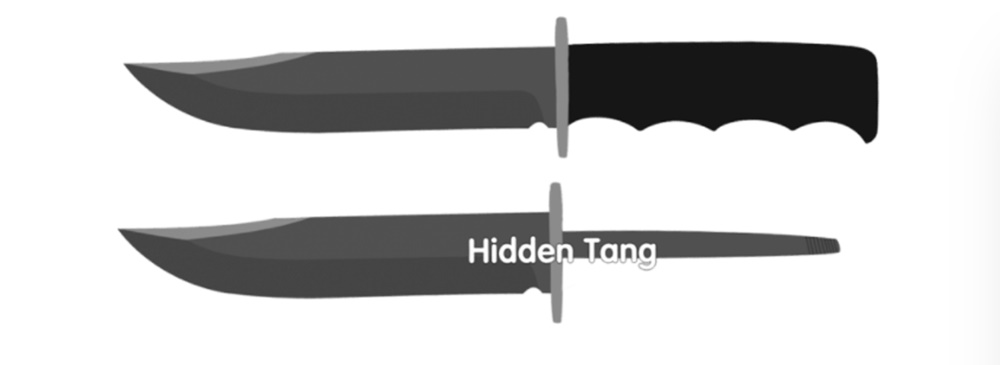
How It’s Made
A hidden tang can be made by pushing a pre-constructed handle and sealing it with epoxy. Another way is to make the tang longer than the handle, and then use a pommel to fix it. Hidden tangs take longer to make, so you are most likely to find them in handmade knives.
Uses
Hidden tangs are popular in handmade knives and are preferred for aesthetics. Some hidden knives can also be used for outdoor or everyday use.
Pros
- They are made for the show
- Are strong and provide more control
- Lightweight
Cons
- Harder to make
- They are not as strong and reliable as full tangs
Skeletonized Tang
A skeletonized tang extends to the length and width of the handle, but it has some parts removed from the center to form a skeleton. Some skeletonized knives can be used without a handle, or you will find some used wrapped with cord-wrapped handles.
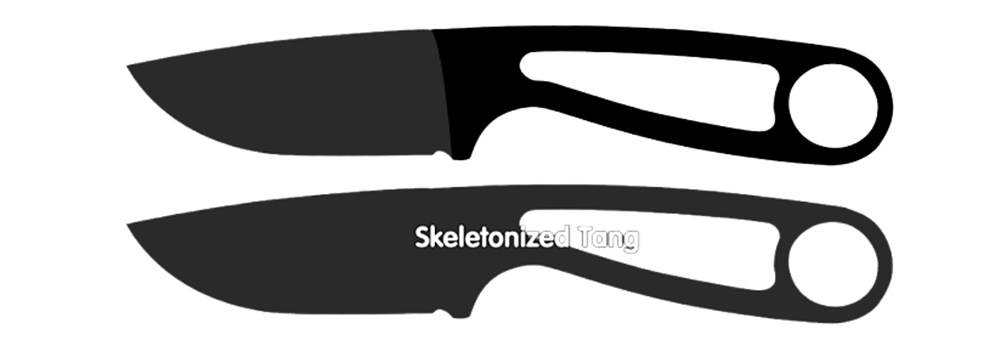
How It’s Made
A skeletonized tang is made from one piece of steel with the center material removed. The first inch of the tang is the weakest, so they remove the material beyond the first inch in order to preserve the weak part.
Uses
Because of their lightweight, skeletonized tangs are mostly used in throwing knives.
Pros
- Lightweight
- It offers better strength because the material is removed from the center and not from the sides
- Durable and stable
- It offers a better balance because it has a large surface area
Cons
- Weaker depending on the size and shape of the cuts.
Encapsulated Tang
Encapsulated tang is a type of full tang whose handle is moulded around the tang instead of being held in place by rivets or pushed through. Also, the tang is not visible.
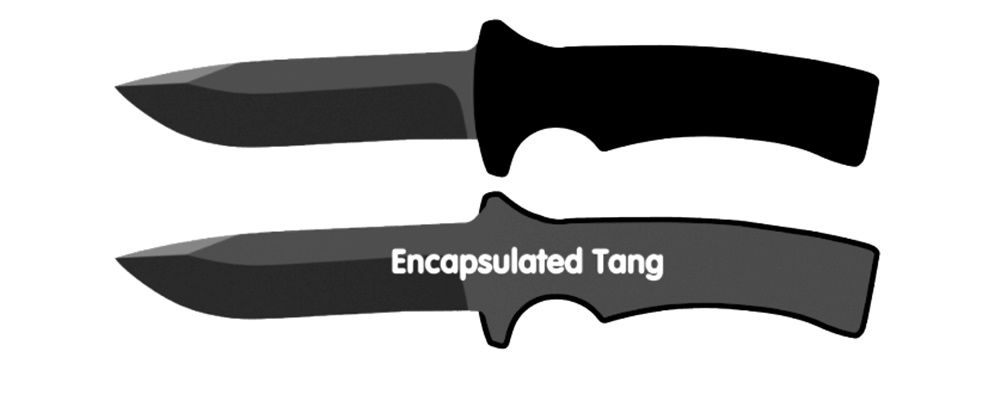
How It’s Made
The most common method of constructing an encapsulated tang is where manufacturers fill a mould with moulded knife grip material, insert the tang inside and remove it after it is set. With this construction method, the tang is not visible.
Uses
- They are used on outdoor knives because they are very strong and sturdy.
- Some manufacturers use encapsulated tangs for good looks because the tang is hidden.
Pros
- It offers a lot of strength
- Offers control and balance
- Allow for precise cuts
- More aesthetic because the tang is hidden
Cons
- It can only be achieved with knife handle materials that can be moulded
Extended Tang
An extended tang extends beyond the knife handle. The protruding part can be used as a hammer pommel, or it can be used to fix the tang. The extended tang is curved or shaped to ensure maximum comfort when using the knife.

How It’s Made
The tang is made longer than the handle and is curved or shaped for safety and comfort. The tang is encapsulated or sandwiched between knife handles and held in position using epoxy or nuts.
Uses
- Extended tangs are used for survival and outdoor knives
- The knife butt is sturdy and can be used as a hammer to crack nuts, kill snakes, or peg tents.
Pros
- It provides stability and strength because it runs through the entire handle
- The hammer comes in handy for simple outdoor tasks
- The extended portion may have a lanyard hole for extra security
Cons
- Heavier knife because of the excess metal
- Some people find that the extended tang gets in their way
- The design restricts the type of material used to make the handle
Partial Tang
A partial tang is where the blade extends partially into the handle. It does not cover the entire length of the grip, and its size is determined by how far it goes into the handle. It can also be referred to as a half tang, three-quarter tang, or stub tang.
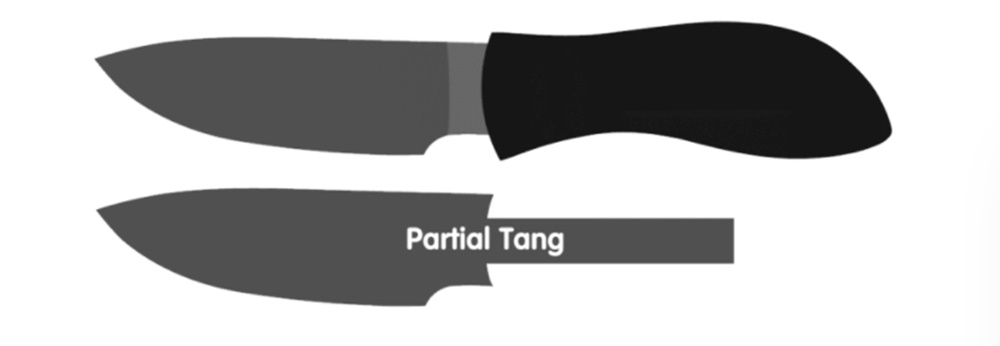
How It’s Made
There are different ways of constructing a partial tang knife depending on its purpose. For instance, the tang can be placed in the middle of two grips and held in place with nuts or rivets; the tang can be pushed through an already-made handle or the grip is molded on the tang.
Uses
Partial tangs are used to make knives that do not need to withstand force or pressure to perform, like decorative knives, wood carving knives, folding knives, everyday carry knives, cooking knives, and swords that are not intended for actual use.
Pros
- Lightweight because there is less metal on the tang
- You can use partial tang knives for long without feeling exhausted
- Cheaper because less material is used
- Suitable for knives with exchangeable grips
Cons
- Prone to breaking under extreme pressure
- Unable to withstand a lot of force because there is less material in the handle
Rat–Tail Tang
Rat tail tang, also known as stick tang, is a very narrow tang that erupts from the knife blade and takes the form of a rat’s body. Rail-tail knives are extremely weak because the tang is very thin and long.
How It’s Made
Manufacturers abruptly narrow the metal from where the tang meets the handle. The rat tail is thin and long, covering the handle’s full length. It is attached to the handle by rivets, bolts, epoxy, or pommel.
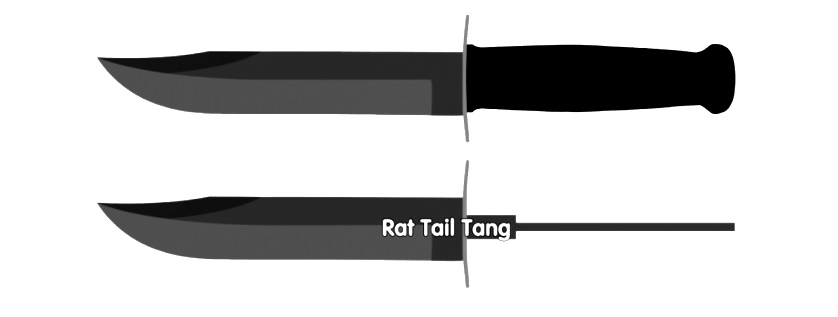
Uses
- Rat tail knife tangs are used for decorative knives and swords because they can take very little force for actual use.
- The tang can also be used for cooking and everyday knives for tasks that require less force.
Pros
- Suitable for decorative knives
- Lightweight
- Requires less material to make
- It is inexpensive
Cons
- Weakest knife tangs on the market
- It cannot be used for heavy knife tasks
- Lacks durability and balance
Push Tang
A Push tang does not extend to the full length of the knife handle and is pushed into a pre-manufactured knife handle and held in place using epoxy.
How It’s Made
As the name suggests, push tangs are literally pushed into an already made handle and secured using strong epoxy. The tang is enclosed inside the handle, so polishing is not necessary.

Uses
Push tangs are used in cheap and lightweight knives to handle simple tasks around the house.
Pros
- Lightweight
- Inexpensive
- Easy to manufacturer
Cons
- Push tang blades are weak and can easily separate from the blade when used for heavy tasks.
Tapered Tang
A tapered tang is a type of partial tang that narrows down towards the end of the handle. It is also called a narrowing tang. This reduces the amount of steel used without giving up the strength.
How It’s Made
Manufacturers tamper the knife tang gradually in width and thickness. Tapered tangs are custom-made, aiming to create a balanced knife.
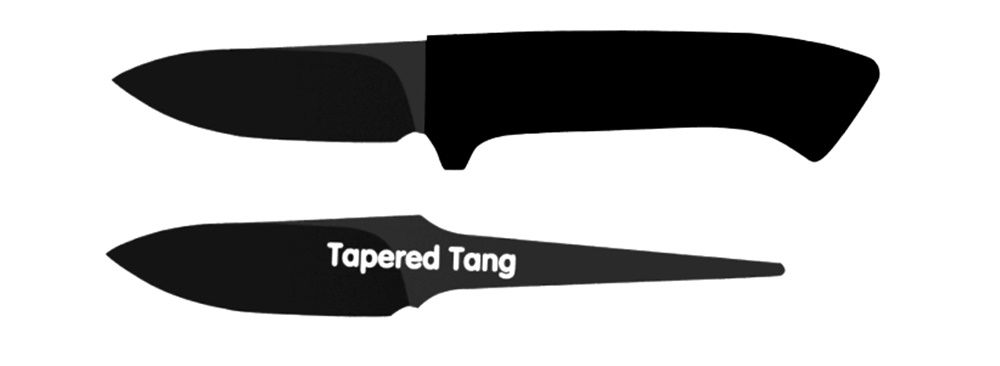
Uses
Tapered tangs are used to make budget knives suitable for lightweight duties or decorative purposes.
Pros
- Lightweight
- Less material needed
- Cheaper to manufacturer
- It makes the knife well balanced
- It’s a showoff of the manufacturer’s skill
Cons
- The narrowing compromises strength and durability
Which Knife Tang Is The Best?
A knife tang influences the strength and stability of your knives. However, the best knife tang for you depends on the type of knife you need and how much you are planning to spend on the knife. Full tang knives offer more strength and durability and are therefore suitable for heavy task duties.
On the other hand, partial knife tangs are ideal for lightweight duties and decorative purposes. Also, full knife tangs are more expensive than partial tangs.
The bottom line is all knife tangs offer good service as long as they are used for the right purpose and properly maintained.

